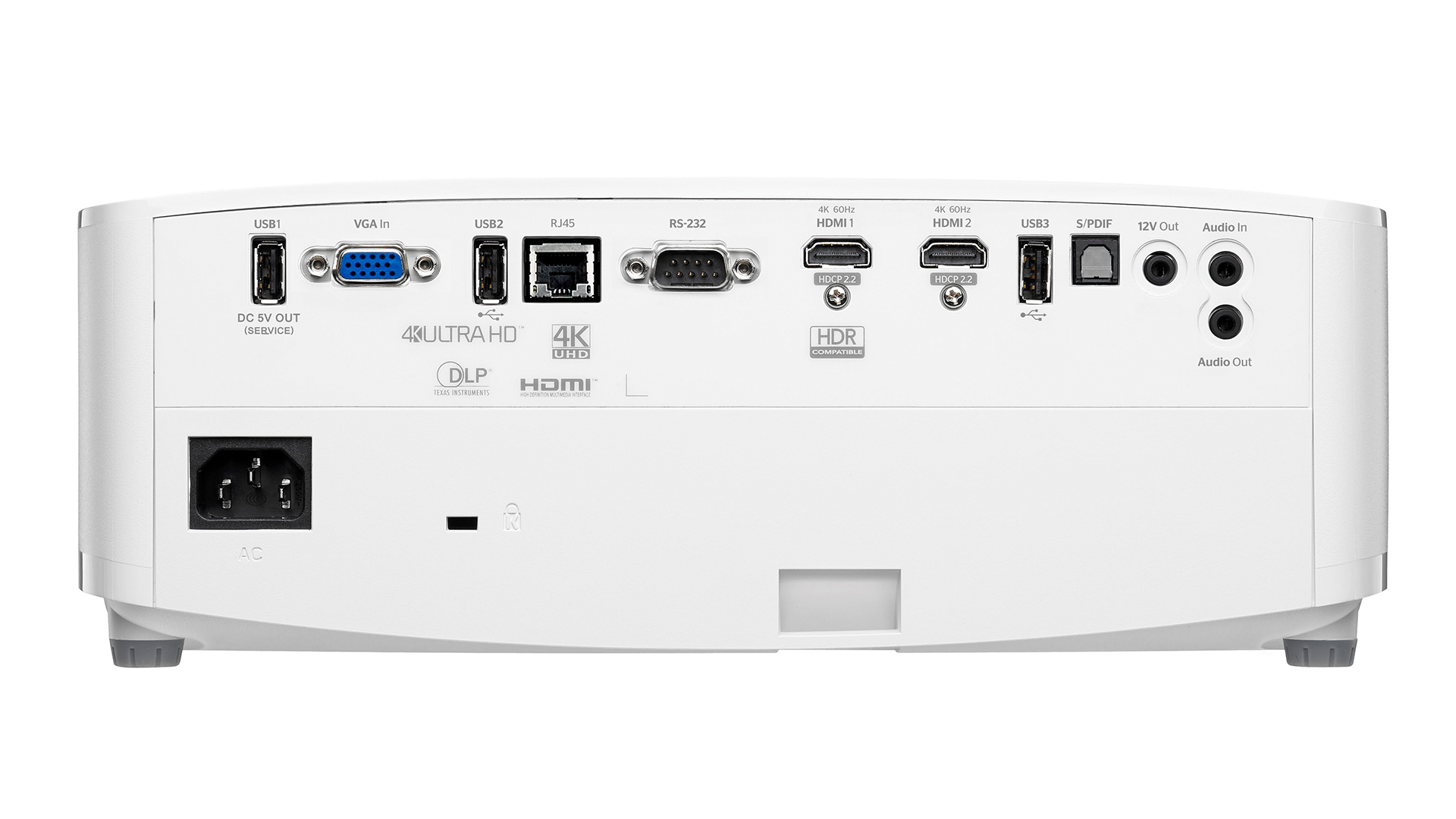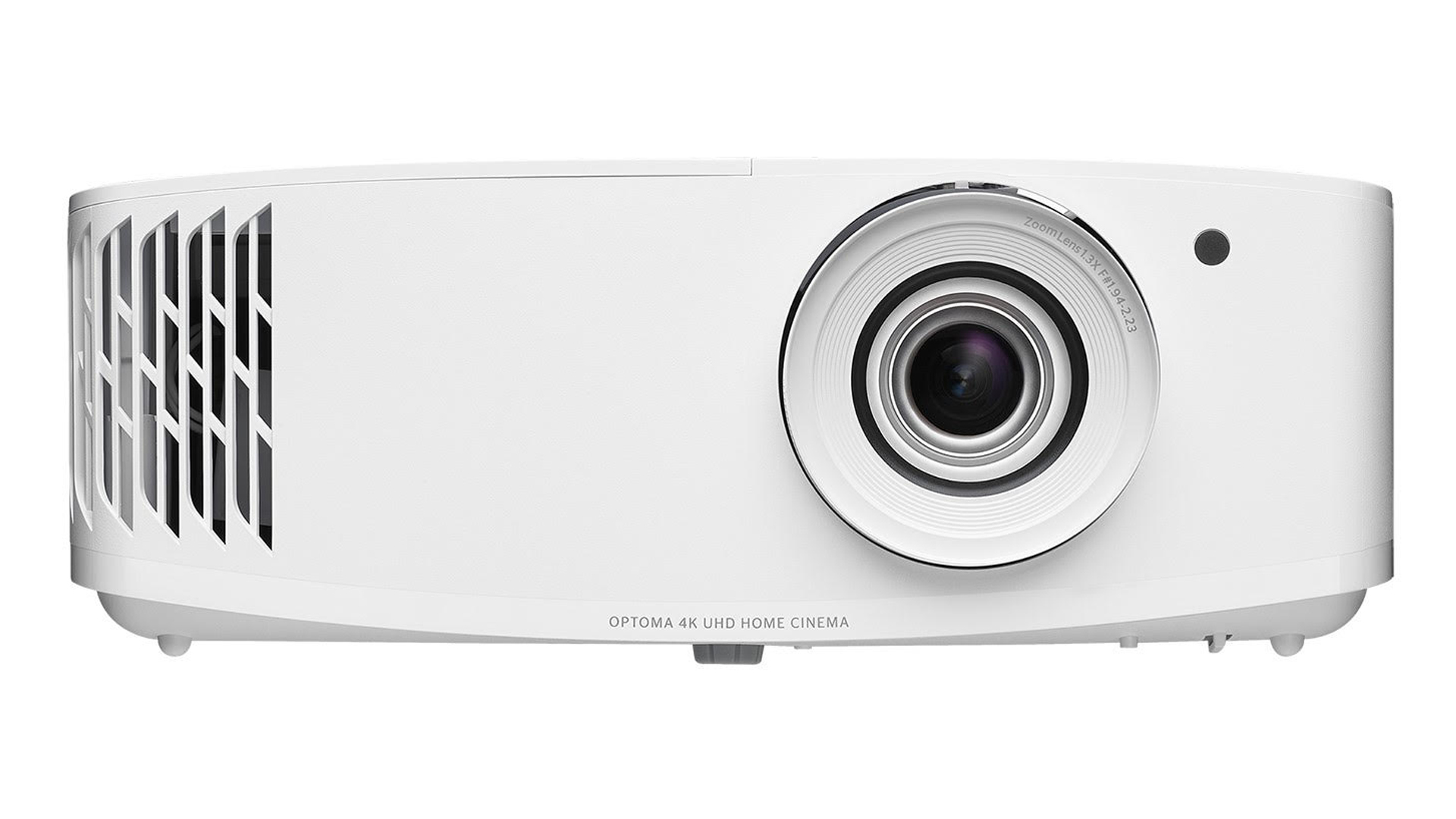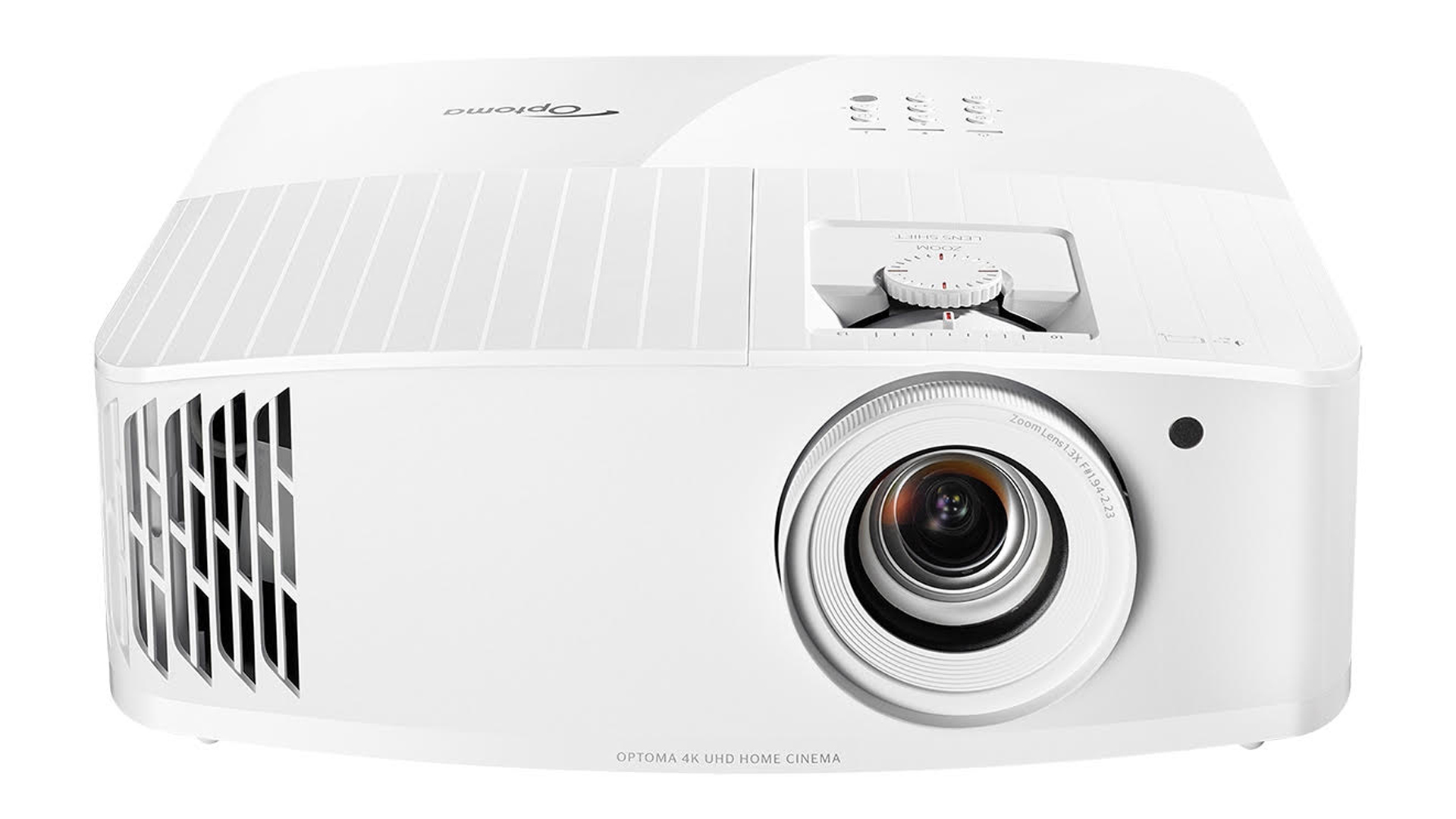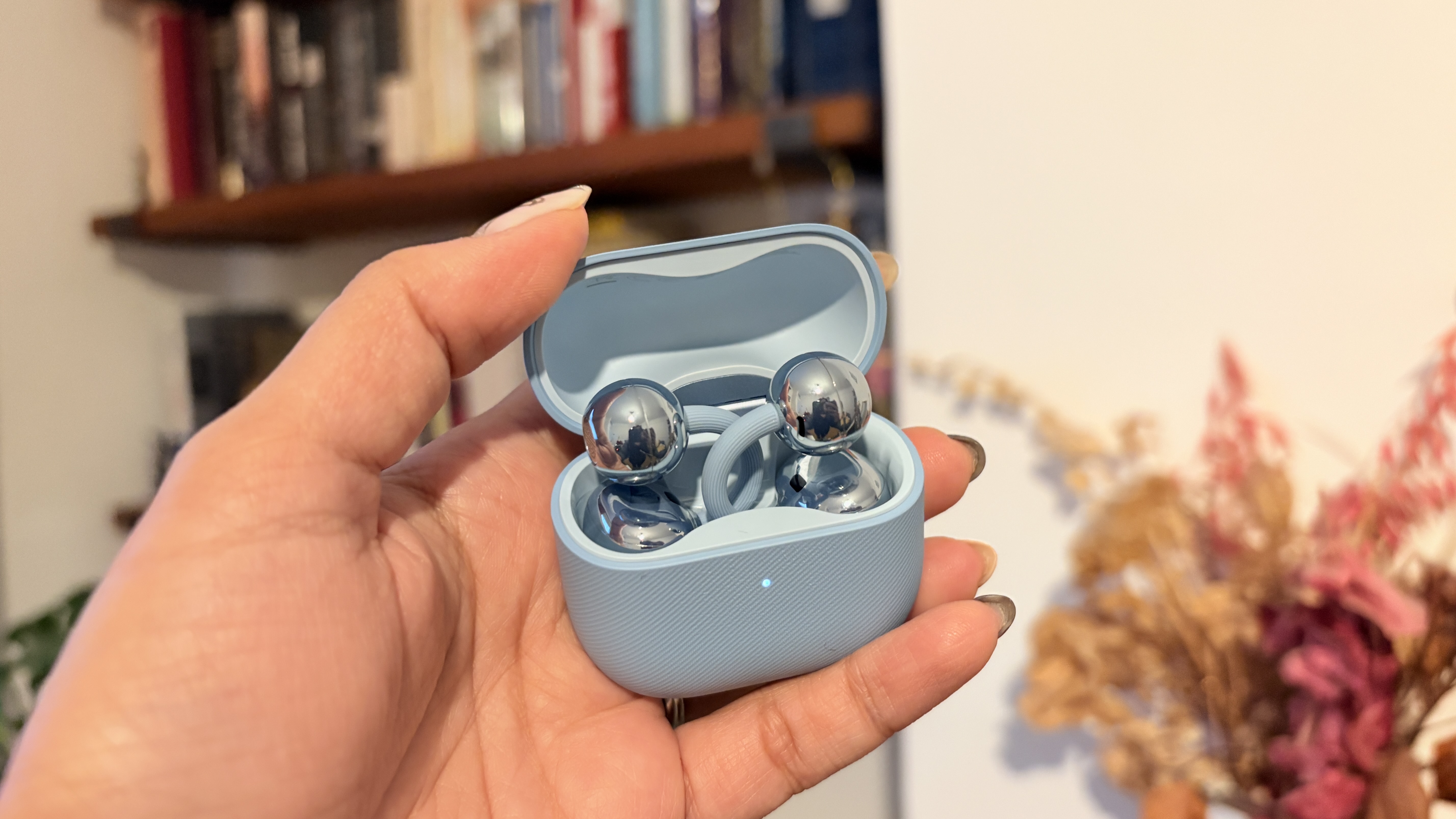What Hi-Fi? Verdict
While occasionally great, the UHD55 lacks the sort of consistency required for a truly immersive home entertainment experience
Pros
- +
Bright and colourful HDR
- +
Fast response time for gaming
- +
Optical vertical lens shift
Cons
- -
Below par native black levels
- -
Light instability in dynamic modes
- -
Unoptimised streaming experience
Why you can trust What Hi-Fi?
The Optoma UHD55 is a perfect example of just how much the humble beam box has evolved over the past couple of years. In keeping with a fast-growing number of affordable home entertainment projectors, it combines support for both 4K and high dynamic range images with a startlingly bright light output, strong gaming features, and even built-in video streaming support. The days where a projector at this price could only be expected to passively deliver dull pictures from only external sources that you’d need to watch in near total darkness are long gone.
Trying to accommodate all the demands of modern home entertainment life, though, can pose quite a challenge for a projector’s picture quality – especially at the relatively affordable end of the market. So has Optoma managed to get the UHD55’s feature and performance balance right?
Price
The Optoma UHD55’s £1400 / $1799 / AU$2799 price is pretty affordable for a lamp- (rather than laser-) based DLP projector that supports 4K and HDR playback. Especially one with a built-in streaming system and enough light output to potentially remain watchable in fairly bright rooms.
There are 4K HDR projectors that cost less these days, but the majority of those don’t back these core picture features up with the sort of impressive-looking secondary image specifications claimed by the UHD55.
Design

Although its size and sculpting are pretty run of the mill, the UHD55 manages to be a snappy dresser thanks to its crisp white finish, a nifty mixture of textures on its top edge and an unusual but attractively ‘gadgety’ optical lens shift wheel that hangs partially over the window you use to access the lens’s zoom adjustment. Focus is adjusted using a ring around the lens’s front.
The lens is promisingly large and offset to the right, while a significant amount of grilling around the projector’s sides happily manages to let plenty of lamp heat out without letting out much light.
The projector’s underside, meanwhile, carries simple screw-down feet to help you get its images beaming to the right height on your wall or, ideally, screen.
The latest hi-fi, home cinema and tech news, reviews, buying advice and deals, direct to your inbox.
The UHD55 ships with an unusually small remote control that’s easy to lose down the sofa, but also easy to use when you can find it. It’s brightly backlit, too, making it usable in even the most blacked out movie room.
Features

Working our way from the Optoma UHD55’s outside in, it’s great to find a projector this affordable providing vertical image shifting to help you get pictures in the right place without having to mess about with image-distorting keystone correction.
The large lens delivers a throw ratio of 1.21:1-1.59:1 and a solid 1.3x level of optical zoom, while connections include two HDMIs, three USBs (one for 5v output or service use only), a VGA port, an RS-232C control port, a 12v trigger port, an optical audio output, and a 3.5mm phono audio loop through.
These latter ports alert us to the presence inside the UHD55 of a built-in audio system. This is rated to 10W, more than you get with most integrated projector sound systems, but it only feeds into a single mono speaker.
The HDMIs support 4K at 60Hz or HD at 120Hz, making the projector potentially attractive to gamers. An attraction it bolsters by keeping input lag to an impressively low 16.9ms when running in its Enhanced Gaming mode.
Turning our attention to the UHD55’s innards, it uses a single-chip DLP optical system delivering a claimed 4K resolution. In truth this means that a 4K image is created by multiple flashes per frame of a less-than 3840 x 2160 roster of the DLP’s digital mirror devices. Some will argue that this isn’t true 4K, but the Consumer Technology Association in the US reckons it qualifies, while our own experiences suggest it can deliver a much closer-to-true-4K image than other ‘pseudo’ 4K approaches.
Beyond the handy physical image set-up tools discussed already, the UHD55’s menus include a surprisingly sophisticated, multi-point image geometry adjustment that potentially allows you to compensate for bulges in your wall, as well as a series of wall colour compensation options.
The UHD55’s 4K resolution isn’t the only big number on its spec sheet. It also claims a seriously high peak brightness of 3600 lumens and an even more promising contrast ratio of 1,200,000:1. This latter figure, though, will be the result of a heady combination of optimism and dynamic light management, meaning you’ll almost certainly never get close to such a contrast ratio during real-world viewing. Two dynamic picture modes are provided: Dynamic and Eco+.

Display Technology DLP
Resolution 3840 x 2160 via double flashing
Screen size Up to 302.4 inches
Brightness 3600 Lumens
Light Source Lamp
As with most HDR-capable projectors, the UHD55’s HDR format support includes the HDR10 and HLG formats, but not the more advanced Dolby Vision or HDR10+ systems. The 3600 lumens of claimed brightness should help the projector get more impact out of HDR than many projectors – provided the contrast lives up to its billing as well.
The high brightness may also enable the UHD55’s pictures to remain watchable in ambient light, as well as helping to combat the inevitable dimming effect you get when you don (not included) glasses to take advantage of the projector’s 3D capabilities.
Optoma claims the UHD55 can cover an impressive (for its money) 97 per cent of the DCI-P3 digital cinema spectrum. This bodes well for the UHD55 avoiding the washed out, flat colours you can get with very bright displays that don’t carry a commensurate colour range.
The most surprising thing about the UHD55 is how smart it is. It runs a customised version of Android TV, and can be connected to your network via Ethernet or wi-fi. This customised Android system doesn’t support Google Play Services, though, and while it’s possible to get apps for Netflix, Amazon Prime Video and YouTube, these apps have not been optimised for the projector and so deliver sub-standard results. You’d be better, in all honesty, adding an external streaming stick if you want to stream into the projector.
You can also play files from USB sticks, and a Creative Cast system/app is on hand to help you share content – including documents as well as images – from Android, iOS, Windows, MacOS or Chrome devices. There’s even support for both the Alexa Smart Home or Google Action (Home) Digital Assistant voice control systems. Though honestly, with the main streaming system being so ineffective, we don’t find ourselves feeling inclined to use any of the UHD55’s smart features all that much.
Picture

While the Optoma UHD55 talks a good talk, its pictures aren’t consistent enough to make it the home entertainment hero we were hoping for.
The UHD55’s most fundamental problem is its underwhelming black level response. Dark scenes and dark parts of the picture look distinctly grey rather than black, immediately denying them the sort of immersive naturalism and sense of depth the projector is capable of delivering during bright scenes and shots. Especially as the greyness can effectively crush subtle details in dark scenes out of the picture.
This is especially true when using the Bright preset the projector defaults to with high dynamic range content. However, while switching the projector to its much less bright Eco mode takes the edge off the dark scene greyness, it also takes so much brightness out of the picture that it no longer looks like HDR.
The best balance between black levels and brightness with HDR sources is achieved using the UHD55’s Dynamic or Eco+ modes, which manipulate the projector’s brightness in response to the image content being shown. Both of these presets make the image instantly and massively more enjoyable. In fact, the difference they make when you toggle to them during a dark scene is so profound that it feels like you’ve suddenly wiped a glob of old chip fat off the lens.
Unfortunately, though, the relief you instantly feel from moving to one of the dynamic picture settings proves short lived. You quickly start to notice that the image doesn’t look stable like it did in Bright mode, as the dynamic iris keeps adjusting light levels so aggressively that you can clearly see jumps in the image’s brightness whenever there’s a sharp cut between a dark and light shot, and vice versa.
In fact, when there’s a sharp cut from a dark to a very bright shot, the UHD55’s response when using its Dynamic or Eco+ modes can cause the picture to actually flash like a bolt of lightning before settling down to a more stable level.
Even more distractingly, the UHD55’s over-eager dynamic light control system doesn’t only cause distracting light level leaps when there’s a sharp cut, you can at times also see distinct shifts in brightness within a single shot if something enters the image that significantly changes its brightness level. As Betty Ripsom’s mum waits forlornly outside the school for her daughter in It Chapter 1 on 4K Blu-ray, for instance, someone walks across the frame in front of her at one point, causing the entire image to clearly dip in brightness on the UHD55 before it pops back up again once the jaywalker moves off the other side of the image. These sort of in-shot inconsistencies are even more distracting than the cut jumps, and unfortunately both issues crop up with frustrating regularity during pretty much any HDR film.
At this point we should stress that in Dynamic and, especially, Eco+ mode, the core of the UHD55’s pictures is actually pretty sound. Contrast goes from poor in Bright mode, for instance, to at least decent, which also helps the projector sell its 4K detailing and sharpness more emphatically. The impressive clarity isn’t accompanied by any tell-tale signs of over-aggressive sharpness processing, either; everything looks clean and natural.
The UHD55 handles motion exceptionally well in its default settings too, mildly ‘calming’ the sort of judder 24p sources can cause without making the image feel artificial or beset by unwanted processing side effects.
Having less black level greyness to compete with in the Dynamic or Eco+ modes also helps colours in bright scenes typically appear with more vibrancy, dynamism and authenticity than they do using the Bright mode. Optoma’s wide colour gamut claims are clearly more than just marketing hype.
Given how bright and vibrant the UHD55’s picture can get, it runs surprisingly quietly while, as predicted, the UHD55’s high brightness makes its pictures more watchable in ambient light than those of many home entertainment rivals.
Its pictures are affected impressively little for such a light cannon, too, by DLP’s so-called ‘rainbow effect’ fleeting colour stripe problem.
The UHD55’s core black level and light control issues mean, though, that it can’t adapt to dark room movie nights as well as we’d like. And while its lack of rainbowing is good, other aspects of its colour performance highlight again how difficult/impossible it is to settle on a single, consistent UHD55 picture setting that works for every image scenario a film typically throws up. This is because, during dark scenes, the Dynamic or Eco+ modes you need to deploy to enjoy anything like a convincing contrast performance cause colour saturations to look much flatter and more faded than they do in bright scenes. And the only way to restore colour punch during dark scenes is to switch to the Bright preset – which means putting up with this mode’s washed out black levels.
In the end, we find that the light and colour stability issues associated with the UHD55’s Dynamic and Eco+ settings actually drive us to settle on the Bright preset for most movie viewing, despite its substantial black level limitations. So we never feel quite as satisfied with the picture as we should.
Sound

Despite having a little more power to its name than most projector sound systems, the UHD55’s audio should still be thought of as an audio solution of last resort.
For starters you can tell it’s just a mono speaker solution as it lacks the clarity and scale of presentation you’d typically get with a stereo set-up. And since the sound struggles to escape beyond the confines of the projector’s bodywork, it doesn’t really ever sound like it’s coming from the pictures it’s supposed to be accompanying.
A lack of bass leaves dense soundtrack moments sounding a bit tinny, too, but its ability to go quite loud and deliver dialogue with surprising clarity does mean that it is at least usable for very casual (think sporting events or Love Island…) viewing.
Verdict
While the Optoma UHD55 can look great at times, when the pictures you’re watching play to its strengths, its hyperactive light adjustment system and below-par native black levels ultimately make it impossible to settle on a picture set-up that delivers the sort of consistency required for a truly immersive home entertainment experience.
SCORES
- Picture 3
- Sound 3
- Features 4
MORE:
Read our review of the BenQ x1300i
Also consider the BenQ W1800
Read our Epson EH-TW7100 review
Best projectors 2022: Full HD, 4K, portable and short-throw
What Hi-Fi?, founded in 1976, is the world's leading independent guide to buying and owning hi-fi and home entertainment products. Our comprehensive tests help you buy the very best for your money, with our advice sections giving you step-by-step information on how to get even more from your music and movies. Everything is tested by our dedicated team of in-house reviewers in our custom-built test rooms in London, Reading and Bath. Our coveted five-star rating and Awards are recognised all over the world as the ultimate seal of approval, so you can buy with absolute confidence.

